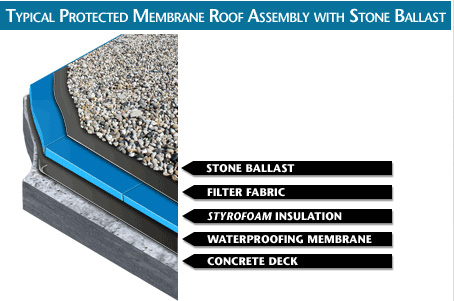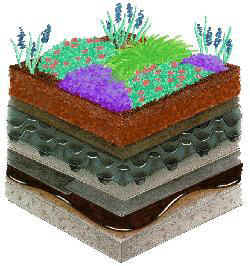

| SHERIDAN COLLEGE |
| School of Applied Computing and Engineering Sciences |
| ARCHITECTURAL TECHNOLOGY |
| ARCH 21158 ARCHITECTURAL DETAILING 2: Commercial |
MODULE #06: Common Roof Assemblies
Learning Outcomes
"By the end of the module, Learners will be able to:
Contents
1. The Protected Membrane Roof
2. Green Roofs
1.
The Protected Membrane Roof
ADVANTAGES:
membrane is protected from damage resulting from the effects of sun, weather, wear, impact
membrane stays at a relatively constant temperature reducing freeze / thaw cycling
moisture membrane triples as a vapour retarder and air barrier
DISADVANTAGES:
may float if drainage and ballasting is not planned
susceptible to standing water build-up if not sloped and drained properly
FUNCTIONAL COMPONENTS:
STRUCTURAL DECK: 3 variations: site concrete, precast concrete, GWB on steel decking on OWSJ
AIR BARRIER, VAPOUR BARRIER, WATER BARRIER: Hydrotech's monolithic rubberized asphaltic membrane 6125
THERMAL BARRIER: 100mm styrofoam roofmate DC extruded polystyrene roof insulation (DC - drainage channels)
FIRE PROTECTION: 2 storey Group D fire rating not required if sprinklered
AESTHETICS: flat roof is not visible. Aesthetic choice is the coping.

For comparison of conventional and protected roofs see the entire slide show on the DOW Chemical Website.
http://building.dow.com/styrofoam/na/pro-canada/tools/benefits/slideshow.htm
OPTIONAL / ADDITIONAL COMPONENTS:
pre-cast conc. deck pavers as ballast.
LINKS:
insulation: www.dowbuildingmaterials.com
membrane technology: www.hydrotechusa.com or tremco or www.sopremaworld.com

ADVANTAGES of GREEN ROOFS:
1) energy efficiency:
soil acts as insulation reducing heat loss therefore lowering energy costs due to heating
absorb and or reflect solar radiation reducing heat gain therefore lowering energy costs due to cooling
2) manage storm water on the roof surface therefore reducing storm water run-off in municipal watermains
3) adds valuable green space open space amenity area
4) creates habitats for plants, birds, insects
5) air/vapour/moisture membranes are one and the same
6) wet soil helps to slow the process of spread of fire
7) membrane is protected from:
A) wear due to pedestrian traffic,
B) ultraviolet degradation due to exposure to sunlight
C) temperature fluctuations so it's life is extended
8) Soil acts as a sound insulator for quieter buildings
9) do not underestimate enhancement of resale value and marketability
10) low profile extensive gardens can replace the ballast on a typical inverted roof
11) green roofs filter the air and provide habitat for some species
DISADVANTAGES:
1) more expensive than conventional roofs
2) gardens need continual maintenance until plants are established
3) intensive planting is complex and may require irrigation
4) wet soil is heavy and may require more substantial structure
5) in retrofit situations there are limitations of access and existing structural capacity
ENVIRONMENTAL IMPACT AND SUSTAINABILITY
TORONTO, June 3, 2006 (GLOBE-Net) - Researchers at the University of Toronto have completed a ‘life-cycle assessment’ of a green roof in order to confirm that ecological rooftops can provide significant environmental benefits. In the case-study undertaken, annual energy savings from a simple green roof amounted to 1.2%, summer cooling needs were reduced by 6%, and water runoff and pollution were reduced.
- environmental impacts of the building were reduced by between 1.0 and 5.3%
- benefits afforded to wider environment included 5% decrease in eutrophication (the excessive accumulation of nutrients) and abiotic depletion (loss of natural environmental resources and minerals)
- 2.5% drop in potential human and aquatic toxicity
Conversion of available 50 million sq.m. of rooftop in Toronto to green roofing would mean:
- reduced storm-water runoff = infrastructure savings of $79 million
- erosion control = savings of $25 million
- pollution avoidance = $13 million
- an additional three ‘beach days’ in the city each year
- reduced energy demands during peak cooling periods = save $68 million
- reduced urban heat island effects
- reduced air pollution
- city beautification
Extensive vs Intensive Roofs
Top is an extensive roof
Extensive and intensive roofs can be differentiated by the depth of the growing medium, the choice of plants and their respective costs.
Lower roof is an example of an extensive roof
Extensive Roofs
Shallower soil ( up to 150 mm), therefore lower weight, lower cost, lower plant diversity, minimal maintenance
Extreme desert -like microclimate requires very hardy plant material (alpine dryland or indigenous varieties)
Tend to be less attractive as a result
Intensive
Roofs
Deeper soil (200mm- 600mm) therefore more weight, greater plant diversity therefore more cost
Can develop a more complex ecosystem
Requires watering / irrigation
With careful design and expert consultation these spaces can be very attractive.
Accessible vs Inaccessible Roofs
If a green roof is to be used as an amenity space by the general public then a number of issues come into play.
Firstly, the designer must consider the method of bringing the public up there. If there is a fire alarm sounded while it is occupied the people must be safely exited to the ground plane. The access therefore must be designed also as an exit. If the roof is unoccupied then a service hatchway will suffice. Our roofs will be accessible. Begin to plan the access/egress....
Secondly, if the people using the roof can walk to edge then the roof parapet must be designed as a guard. ( ie 1070mm high)
Special design considerations:
roof must be designed for exiting
roof must be designed to carry the extra dead and live loads (increased structural cost)

vegetation layer
soil / substrate layer
filter fabric
drainage layer
moisture retention mat
rigid insulation
root barrier protection course
roof membrane
structural roof deck
FUNCTIONAL COMPONENTS:
STRUCTURAL: 3 assemblies assigned: site cast concrete, pre-cast concrete, steel deck on OWSJ
AIR BARRIER, VAPOUR BARRIER, WATER BARRIER: monolithic rubberized asphaltic membrane (eg. Hydrotech's MM6125-EV)
THERMAL BARRIER: 50mm rigid polystyrene insulation
FIRE PROTECTION: not required if building is sprinklered
AESTHETICS: attractive garden amenity spaces can be landscaped beautifully to create an amenity space
OPTIONAL / ADDITIONAL COMPONENTS:
vegetation layer: hardy plants with shallow root systems, resistant to direct solar radiation, drought frost wind resistant, regenerative.
soil / substrate layer: mixture 75% mineral soil 25% organic soil
root barrier: Root Stop WSF 40 is loose laid over Hydroflex 30 barrier embedded into warm tacky MM6125-EV rubberized asphalt membrane
filter fabric: non-woven, non-rotting polypropylene geotextile filter sheet to keep the soil out of the drainage layer
water retention mat: non-rotting polypropylene fibre (Hydrotech SSM45)
drainage layer: Floradrain FD40
LINKS:
The City of Chicago Experience
The City of Toronto Experience
Green Roof Designers, Installers, Consultants ZinCo or Tremco
Green Roof Industry Association with links to suppliers, articles case studies